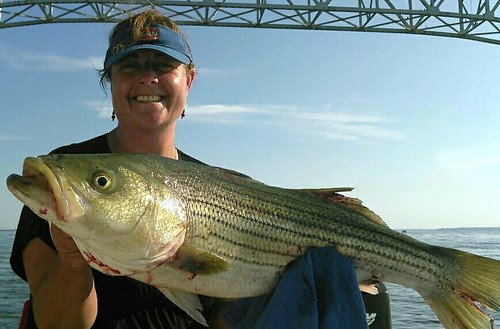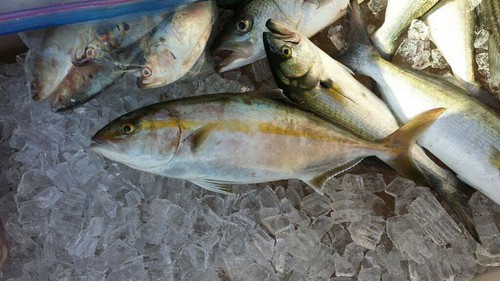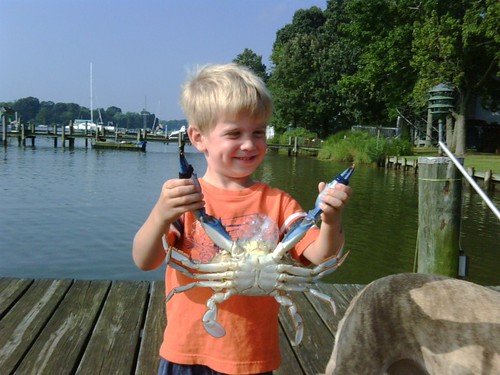By: Keith Lockwood
Hot weather has descended upon Maryland and while some of our fisheries are slowing down to warmer water temperatures, others such as marine are creating new opportunities as summer migrant fish move into our waters.
At the top of the bay the Conowingo Dam has been flat lined for over 8 days with hardly any water releases. Higher water temperatures have many fish hunkered down waiting for an influx of cooler water that occurs with power generation water releases. Channel catfish and white perch are providing most of the action in the lower Susquehanna and the tidal rivers to the south. There continues to be some early morning striped bass and white perch action in the tidal rivers near Rock Hall and the Baltimore Harbor area for those casting near shoreline structure or jigging along channel edges. White perch can also be caught during the day on bait in deeper water waters.
Chumming for striped bass in the upper bay continues to be a big draw for boats from ports as far south as the lower bay this week. Swan Point, Love Point and the western side of the shipping channel from above the mouth of the Magothy River to Sandy Point Light have been getting the most attention. The 30' to 35' edge tends to be the sweet spot and it is hard to beat a falling tide for the best action. Water temperatures are about 85° and warm water stress and deep hooking of released fish is taking its toll so anglers are urged to exercise caution to protect the future of the striped bass fishery in Maryland.
Trolling deep with umbrella rigs and single lures has been an effective alternative to chumming lately as has jigging when fish can be found suspended along channel edges or near structure. Live lining white perch is also a very effective tactic where fish can be spotted suspended near channel edges. The Bay Bridge piers and rock piles are holding striped bass and jigging or live lining white perch there can really pay off. Dee Kolobow holds up a nice 33" striped bass she caught near the bridge piers on a live white perch.

Photo courtesy of Dee Kolobow
In the middle bay region striped bass are being found along channel edges in about 35' of water on the outside edge of Hacketts and outside Poplar Island to Buoy 83. There is a little chumming going on but most are spotting suspended fish and either jigging or trolling for their striped bass and bluefish. Breaking fish are becoming a more common sight as bluefish join up with striped bass to harass schools of menhaden and bay anchovies along channel edges. Casting into the breaking fish or jigging underneath has been providing some fun action.
The shallow water striped bass fishery is slowing down as water temperatures in the shallower areas climb into the upper 80s which is a bit toasty for striped bass over 20 inches long. There is some action before the sun comes up and just before sunset on the higher tides. The warm water temperatures are having an effect on the shallow water white perch fishery as well and the action can be spotty at times. Fishing deeper water with bait or jigs around structure such as piers or oyster beds tends to be the best option.
In the lower bay, fishing for cobia is still holding center stage as the most exciting fishery. The prize is great and it has been a very long time since Maryland fishermen have had such an opportunity to catch a cobia. Most are chumming near the Target Ship, the Mud Leads or the Middle Grounds and catching a mix of bluefish, a striped bass now and then and hopefully a cobia. The cobia fishery currently remains open in Maryland state waters in the Bay, and state waters in the ocean, within 3 miles of the coast. The Maryland Department of Natural Resources Fisheries Service cannot implement regulations for cobia in Maryland waters unless the species is added to the "in need of conservation" list in the Code of Maryland Regulations (COMAR). The Department does not plan to try listing cobia as in need of conservation this summer but may consider it sometime in the future. The cobia fishery was discussed at the last Sportfish Advisory Commission (SFAC) meeting, and there may be some future discussion with the Atlantic States Marine Fisheries Commission (ASMFC).
There has been a rarely seen visitor to the Maryland portion of the bay in the past week and that is the greater amberjack. Juvenile amberjack in the 26" to 30" size range have been caught as far north as the mouth of the Choptank by chumming, trolling and casting to breaking fish. Travis Long sent us a picture of what one looks like.

Photo courtesy of Travis Long
Bluefish are spread throughout the lower bay region and the first Spanish mackerel were seen last weekend by those casting into breaking fish or trolling small Drone and Clark spoons behind planers or inline weights. Surge tube lures (hoses) have also been a good trolling option for bluefish and the occasional striped bass.
The oppressive heat has driven water temperatures up and has slowed down the shallow water striped bass fishery and limited it to a short period before sunrise and after sunset. Speckled trout have been a welcomed addition to fishing along the bay's marshes and creeks this week. The eastern side of the bay holds the best opportunities but they can be part of the mix while bottom fishing anywhere in the lower bay. Croaker fishing remains an evening proposition due to warm water temperatures along channel edges. At times a few croaker can be coaxed to bite during the day in deep water but the action tends to be sparse. White perch are holding in deeper waters over oyster bottom and are active. Small red drum in the 12" size range are also part of the bottom fishing mix along with a few sea trout.
Recreational crabbing continues to be good in all three regions of the bay with the best crabbing occurring in the middle and lower bay regions. The larger crabs tend to be deep, often in 10' of water or more. Recently molted crabs and small crabs tend to be more of problem and razor clams continue to be the bait of choice. The hot and humid weather we are experiencing is really rough on holding crabs in a basket onboard and picking out dead crabs while loading up the steamer pot can be a big disappointment. Keeping a wet piece of burlap over the basket and out of the sun between runs can help.

Photo courtesy of Jim Livingston
There is no getting around the fact that the hot weather we are experiencing is having a profound effect on freshwater fishing. Water temperatures are up and making it difficult for the fish and those who pursue them. The early morning hours before sunrise tend to hold the best opportunities for fishing places like Deep Creek Lake or the upper Potomac River for smallmouth bass and other cold water fish. Boat traffic on Deep Creek Lake is of course a limiting factor and low, warm and clear water on the upper Potomac is an issue to deal with.
Largemouth bass are moving up into the shallower areas during the night to feed and hunkering down early in the morning to a cool shady spot to wait out the day. Targeting shallow grass early in the morning or late evenings with topwater lures such as poppers and frogs is a good tactic and dropping plastic worms through heavy grass or under docks and brush during the day can offer good action. When fishing tidal waters for largemouth bass a low tide is best when working the outside edges of grass beds or spatterdock fields and creek mouths are also a good spot to target.
Water temperatures in the Ocean City area are holding about 70° this week close to shore. Surf casters are catching a mix of kingfish, small bluefish and flounder in the surf. The best action tends to be early in the morning and late evening. At the inlet bluefish are offering good fishing action in the early morning and late evening hours along with striped bass. Casting Got-Cha lures, bucktails, swim shads and drifting cut bait or live eels has been popular. Flounder are being caught at the inlet and Route 50 Bridge area. Flounder fishing has been very good in the channels leading to the inlet and also farther back in the bays.
Outside the inlet bluefish and Spanish mackerel are being caught by trolling spoons near some of the inshore shoal areas like the Bass Grounds and Little Gull Shoals. Flounder are also present in these areas as well as the wreck and reef sites where they help add to the mix for those fishing for sea bass.
Chunking for yellowfin tuna has become very popular recently and on the weekends a huge fleet can be seen for miles anchored up at Massey's Canyon. It is not a bad run from Ocean City Inlet and inviting for those hesitant to run out to the farther offshore canyons. Darren Rickwood holds up a fine example of the yellowfin tuna that are being caught while chunking.

Photo courtesy of Darren Rickwood
There has also been some action at other spots such as the nearby Chicken Bone and farther south at the Lumpy Bottom. At the Washington, Poorman's and Baltimore Canyons there is a mix of dolphin, yellowfin tuna, bluefin tuna, wahoo and white and blue marlin being caught, mostly by trolling.
Boom...Morgan
No comments:
Post a Comment